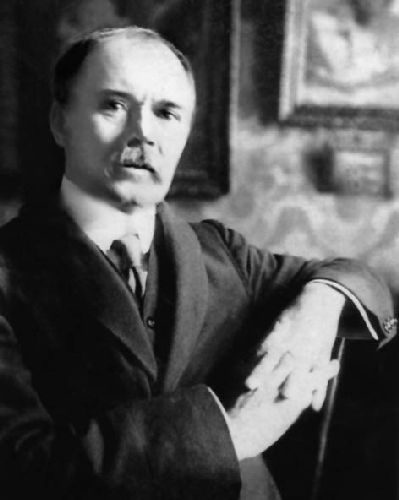- Home
- Gansky Petr - impressionist from Odessa
Gansky Petr - impressionist from Odessa

Gansky Petr (1867–1942) was a remarkable Odesa artist from the late 19th and early 20th centuries. A member of the Society of South Russian Artists and an active participant in its exhibitions, Gansky left behind a unique body of work whose emergence into the art world has been nothing short of a revelation.
A significant event in September 1994 at the Odesa Art Museum sparked a renewed interest in Gansky’s name. Two elderly ladies from Tallinn, Elena Borisovna Pozdnyakova and Tatyana Borisovna Zolotova, hesitantly inquired about the artist and whether the museum held any of his paintings. Upon seeing his canvas “By the Pond” on display, they were visibly moved and delighted. It turned out they were Pyotr Pavlovich’s nieces! This touching moment opened the door to invaluable family archives, including photographs, watercolor sketches from the artist’s later years, and precious memories that illuminate his long and eventful life.
A nuanced master and innovator: his early path
Unlike more public figures, Pyotr Gansky was known as a nuanced, refined artist. Nevertheless, his name consistently appeared alongside renowned Odesa masters such as Kyriak Kostandi, Pyotr Nilus, Tit Dvornikov, Gerasim Golovkov, and Yevgeny Bukovetsky. His works were eagerly acquired by collectors and fellow artists, including Aleksandr Russov, Yevstratiy Petrokokino, Nikolay Kuznetsov, and sculptor Boris Eduards. Five of Gansky's pieces entered the museum's collection through these very acquisitions. The press of that era often noted his innovative, extraordinary talent, frequently calling him an Impressionist.
Pyotr Pavlovich was born on March 21, 1867, into a noble family in the village of Nikolaevka (Ganskoye), Ananyevsky district, Kherson Governorate (now Odesa Oblast, Ukraine). The Gansky family, which settled in Novorossiya during the reign of Catherine II, had deep historical roots. The artist's father, Pavel Petrovich, was educated in France and served as the manager of the Kherson Noble Bank. From 1870, the Gansky family resided permanently in Odesa, where Pyotr's younger brother, Alexey Pavlovich Gansky, was born – he would later become a celebrated astronomer and geodesist.
Pyotr Gansky began his art education in Elisavetgrad, and then, from 1885 to 1889, was a non-degree student at the Imperial Academy of Arts in Saint Petersburg. He completed his training in Paris at the prestigious École des Beaux-Arts under the guidance of Jean-Léon Gérôme. From 1890 onwards, Gansky actively participated in all exhibitions of the Society of South Russian Artists, becoming a full member in 1894. He created landscapes, portraits, and genre compositions, regularly exhibiting his works in Odesa even while living abroad.
Trials of revolution and a new path in exile
The 1917 Revolution found Pyotr Gansky in Odesa after his latest return from Paris. His estate was destroyed, and the artist himself was sentenced to execution by the Bolsheviks. According to a well-known legend, he narrowly escaped death thanks to the arrival of Denikin's Volunteer Army in Odesa. However, recent research of documents, including interrogation protocols, indicates that Gansky was ransomed from the Cheka by the Bunins, while other individuals involved in the case of the Russian People's State Union were likely executed.
In December 1919, Pyotr Gansky was evacuated from Odesa via Thessaloniki on the British ship “Rio Pardo,” leaving his homeland behind forever. From 1920, he permanently resided in France, where his sister Sofya and her family already lived. Despite his emigration, he continued to work actively, refining his craft in Paris.
In 1922, the artist's life took a new turn: he converted to Catholicism and later, in 1928, was ordained to the priesthood by Cardinal Maurand. Pyotr Gansky became a priest of the Jesuit Order of the Byzantine Rite, dedicating himself to service within the mission of the Russian Catholic Apostolate. His friendship and correspondence with Nicholas Roerich played a crucial role in disseminating the Roerich Pact among prelates of the Roman Catholic Church, which ultimately led to its subsequent signing by Pope Pius XI.
Even as a Catholic priest, Pyotr Pavlovich Gansky never abandoned his painting until his death, actively assisting Russian refugees in France by donating his artworks for charity lotteries.
Oblivion and the triumphant return of his legacy
Pyotr Pavlovich Gansky passed away on November 27, 1942, at a monastic hospice in Le Dorat, France, where he was also buried. He left behind an extensive archive, including manuscripts and a fantastic novel titled “The Red Star,” which are preserved in the French state archives. Most of his legacy was held by his sister and niece in Tallinn, and it was only in 1994, thanks to the efforts of his nieces Elena Pozdnyakova and Tatyana Zolotova, as well as the chief custodian of the Odesa Art Museum, Lyudmila Eryomina, that over thirty of Gansky’s works were transferred to the museum. In 2004, the collection was further enriched with forty more works, forming the largest museum collection of Pyotr Gansky’s art — 84 pieces are now housed in the Odesa Art Museum.
Today, Pyotr Pavlovich Gansky’s paintings grace the exhibitions of the Odesa Art Museum, the National Art Museum of Ukraine, the Mykolaiv Art Museum named after Vasyl Vereshchagin, the House of Russian Abroad named after A. Solzhenitsyn, as well as private collections in Odesa, Kyiv, Tallinn, and Paris.
Gansky’s work, long known only to a select few, is once again gaining recognition. His paintings, which combine academic technique with Impressionistic approaches, and his unique life story – from an Odesa nobleman to a Parisian priest – make him a figure of exceptional significance for Ukrainian and Russian art. Exhibitions in Tallinn (2014), and a major retrospective at the Odesa Art Museum in 2017 celebrating his 150th birthday, confirm the renewed interest in this talented master.
The study of Pyotr Gansky’s life and work continues to uncover new facets of his unique contribution to art history.
- 30
- 60
- 90







